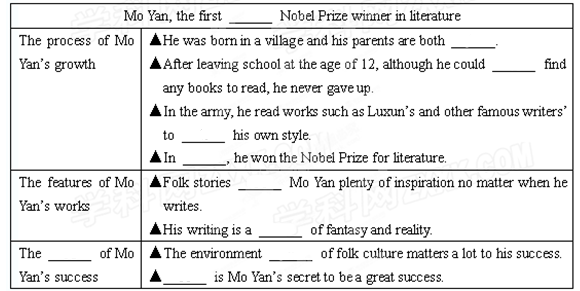Writing a good story is no easy task. What’s the secret? Mo Yan, a Nobel Prize winner in literature, believes his success comes from a large amount of reading.
Mo was born into a farming family in a village in Shandong province. He grew up listening to folk (民间的) stories about gods, spirits and foxes. Those stories later became the inspiration(灵感) for Mo’s writing.
Mo left school at the age of 12 and started to work in the fields. Although he was tired after his daily hard work, Mo was always hungry for books. However, there were very few in the village. He read his elder brother’s textbooks and even dictionaries. He helped others with farm work in exchange for books.
After Mo left his hometown and joined the army in 1976, he began to read widely, including works by Lu Xun and many other famous writers.
He studied from these writers but did not copy them. Instead, he developed his own style. “I grew up in an environment filled with folk culture. It enters my novels whenever I pick up a pen. This has affected, even decided, my style.” Mo told a group of reporters in his hometown shortly after he won the award in 2012.
As the first Chinese citizen to win a Nobel Prize in literature, the organization spoke highly of his works. They described his writing as a mixture of fantasy and reality, combining historical and social perspectives (看法).

小题1:_______小题2:_______小题3:________ 小题4:_______ 小题5:_______
小题6:_______小题7:_______小题8:________小题9:_________小题10:________